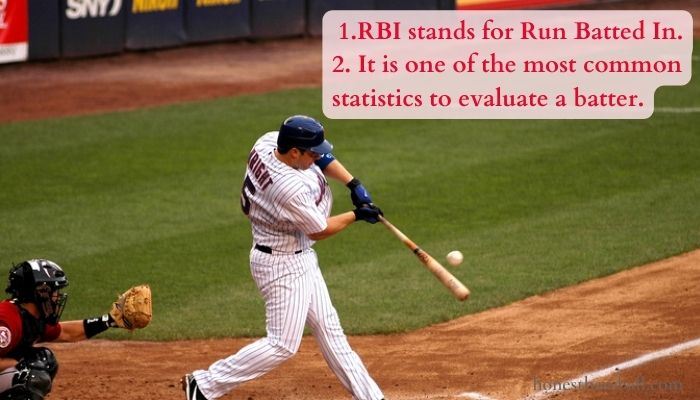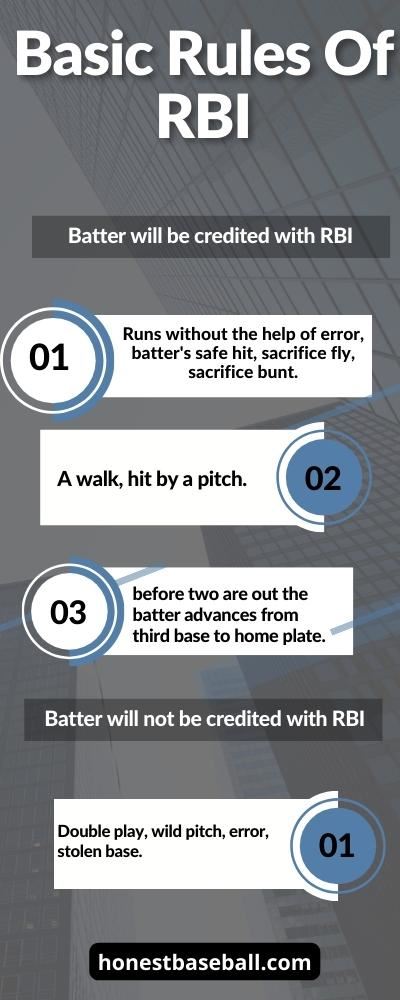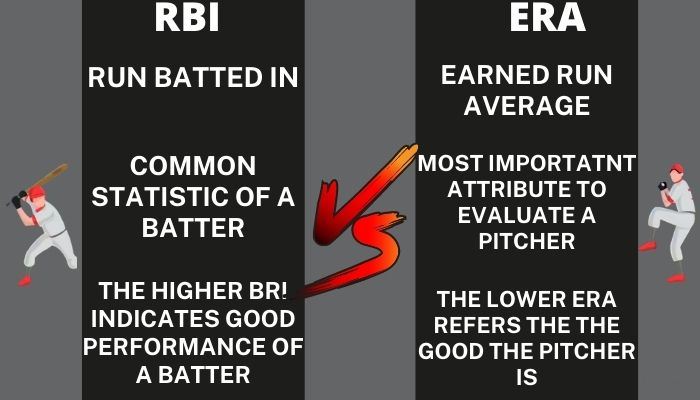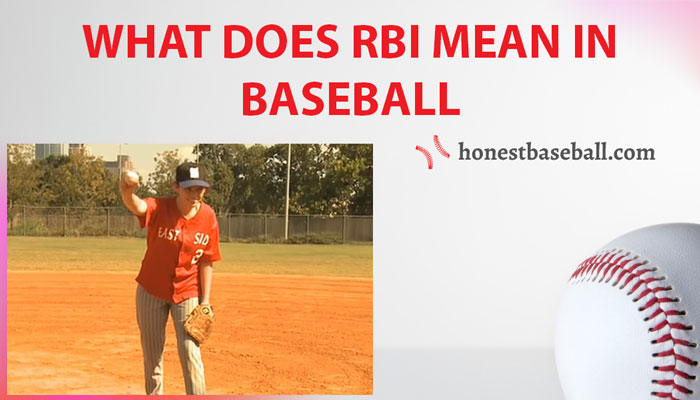RBI is one of the most common statistics in baseball and softball among the hundreds of states. Baseball fans like to see good RBI along with other states, like batting average, Earned Run Average(ERA), WHIP, etc., in their favorite players’ states.
But, if you are new to baseball enthusiasm, you may be asking what does RBI mean in baseball.
The concept of “Runs Batted In” (RBI) is a statistic that evaluates a player’s proficiency in driving in runs for their team, exhibiting their effectiveness on the field. When a player successfully acquires an RBI, it signifies their role in enabling a teammate to score a run.
What Does RBI Mean in Baseball?

RBI in baseball refers to Run Batted In. When a batter hits and this hit allows the baserunners to advance to the next bases, the batter will be credited with an RBI. Simply speaking, the RBi comes when the batter hits a ball.
Aside from hitting, walks and hit by a pitch are also credited with an RBI to the batter. However, multiple RBIs can be credited at a time, which is up to 4.
But, the batter will not be credited if the runs come from an error of the fielder, a wild pitch, stolen bases, or it’s a double play.
Here is How RBI is counted:
RBI can be earned through various means within the game:
- Base Hit: Each run that materializes as a result of a player’s base hit contributes to their RBI tally. This encompasses singles, doubles, triples, and home runs.
- Sacrifice: If a batter makes a sacrifice bunt or executes a sacrifice fly, thus leading to a run being scored, they receive recognition for an RBI.
- Bases Loaded Walk or Hit By Pitch: If the batter is granted first base due to either being walked or being struck by a pitch while all bases are occupied, this compels a runner to advance, ultimately resulting in an RBI.
- Catcher’s Interference: Should interference from the catcher impede the batter’s swing while all bases are loaded, granting the batter first base and forcing any runner home equates to an RBI.
Major League Baseball (MLB) defines RBI as follows.
“A batter is credited with an RBI in most cases where the result of his plate appearance is a run being scored. There are a few exceptions, however. A player does not receive an RBI when the run scores as a result of an error or ground into a double play.
The most common examples of RBIs are run-scoring hits. However, players also receive an RBI for a bases-loaded walk or hit by pitch. Players can earn RBIs when they make outs, as well, provided the out results in a run or runs (except, as noted above, in the case of double plays).
Along with home runs and batting average, RBIs are a part of baseball’s offensive Triple Crown.”
Major League Baseball (MLB)
But, in MLB history, Before the 1920 season of Major League Baseball, runs batted in were not tallied as a statistic in the game of baseball.
However, baseball journalist Ernie Lanigan kept an unofficial tally of RBI from the 1907 through 1919 seasons. His records cover that time period.
Let’s see a visual explanation of RBI in the following video.
Factors Influencing RBI Numbers
Batting Order: A player’s position in the batting order significantly influences their RBI numbers. Batters who occupy the middle slots in the lineup tend to enjoy more opportunities to bat with runners on base, thereby increasing their chances of acquiring RBIs.
Team’s Offensive Strength: The frequency with which a team reaches bases directly impacts the availability of RBI opportunities. Consequently, being part of a formidable offensive team can notably boost a player’s RBI statistics.
Player’s Skill and Performance: A player’s aptitude for delivering under pressure situations, overall batting proficiency, and power (the ability to hit for extra bases or home runs) directly affect their RBI totals.
Games Played: The number of games a player participates in throughout a season undoubtedly influences their RBI numbers. More game time translates into more batting opportunities, which subsequently augments RBI potential.
Health and Longevity: Maintaining good health and enjoying a lengthy career within the sport undeniably exerts a substantial impact on a player’s career RBI figures.
What Are The Major League Baseball Rules For Run Batted In?
Baseball is a game of rules. Thousands of rules are implemented that an official scorer considers before making a decision in the game.
Like others, RBI in baseball also has a bunch of rules set by the 2018 Official Baseball Rule of MLB in section 9.04.
For your convenience, I am going to present the exact rules below on RBI stands.

(a) The official scorer shall credit the batter with a run batted in for every run that scores
(1) unaided by an error and as part of a play begun by the batter’s safe hit (including the batter’s home run), sacrifice bunt, sacrifice fly, infield out or fielder’s choice, unless Rule 9.04(b) applies; Rule 9.03(d) to 9.04(a) 107
(2) by reason of the batter becoming a runner with the bases full (because of a base on balls, an award of first base for being touched by a pitched ball or for interference or obstruction); or
(3) when, before two are out, an error is made on a play on which a runner from third base ordinarily would score.
(b) The official scorer shall not credit a run batted in
(1) when the batter grounds into a force double play or a reverse-force double play; or
(2) when a fielder is charged with an error because the fielder muffs a throw at first base that would have completed a force double play.
(c) The official scorer’s judgment must determine whether a run batted in shall be credited for a run that scores when a fielder holds the ball or throws to a wrong base. Ordinarily, if the runner keeps going, the official scorer should credit a run batted in; if the runner stops and takes off again when the runner notices the misplay, the official scorer should credit the run as scored on a fielder’s choice.”
Why Do Batters Sometimes Not Receive an RBI?
Specific scenarios exist where players contribute to scoring runs without being accredited with an official Run Batted In (RBI):
Double Play: If a batter hits into a double play situation, they are not attributed with an RBI for any subsequent runs scored during that play.
Errors: In cases where an error occurs during a play that would have otherwise concluded the inning, any subsequent runs scored are deemed unearned and do not contribute to a batter’s RBI count.
Fielder’s Choice: When a fielder has the option to make an out on another runner but instead chooses to eliminate the batter-runner, no RBI is awarded for any runs scored during that play.
Passed Ball or Wild Pitch: If a run is scored as a result of a passed ball or wild pitch while the player is at bat, they do not receive an RBI.
Interference or Obstruction: In situations where a run is scored due to interference or obstruction, the batter does not receive an RBI.
What is a Good RBI in Baseball?

Determining what constitutes an impressive number of Runs Batted In (RBI) throughout a baseball career varies considerably based on factors such as the player’s career duration, batting position, and other relevant variables.
Nevertheless, historical data reveals certain benchmarks worth considering.
For example, Hank Aaron holds the esteemed record for accumulating the most RBIs in Major League Baseball history with an impressive count of 2,297.
Other notable players such as Albert Pujols and Babe Ruth boast career RBI counts of 2,218 and 2,214, respectively.
On the other end of the spectrum, an average career RBI count for a batter may hover around 250, with 300 being widely regarded as highly commendable.
Anything in the vicinity of 350 is often perceived as exceptional.
It is worth highlighting that only six players have consistently maintained an average of 100 RBIs per year throughout their careers.
These extraordinary individuals include Ruth, Gehrig, DiMaggio, Pujols, Bagwell, and Belle. This fact underscores the arduous nature of sustaining a high RBI count over an extended period.
What is the difference Between Runs Batted In (RBI) And Earned Run Average (ERA)?

On the other hand, a pitcher’s ERA, also known as their earned run average, is a statistic that keeps track of a pitcher’s performance.
Runs batted in are a statistic that pertains to batters. One might reasonably anticipate that there are substantial distinctions between the two.
Actually, they are two totally different attributes of statistics in baseball. As baseball fans love to see their favorite players’ states both in batting and hitting, here the ERA could be briefly described.
The runs that a pitcher allows over the course of nine innings are what make up their earned run average.
Every run that a team’s hitters score will count against a pitcher’s earned run average (ERA). However, this does not include the runs that were scored as a result of a fielding error or a passed ball.
It is the condition that is used the vast majority of the time to assess a pitcher. The better the pitcher was, as measured by their ERA, the lower it was.
Because it is the job of the pitcher to prevent runs from being scored by the batters and runners during the game.
The lower a pitcher’s ERA is, the better they perform their job. In the context of the competition, the pitcher is solely responsible for the number of runs that are allowed by himself.
By the way, Earned Run Average is a great tool to evaluate the starting pitchers. Evaluating the relief pitchers by ERA could not be that efficient and effective.
On the other hand, RBI is the state that credited a batter with runs in his plate appearances that have already been explained.
By the way, ERA demands extensive elaboration to be explained properly. My guide on “What Is ERA in Baseball?” may help you to learn things about ERA elaborately.
The Relation Between RBI And Base Hit
As I mentioned before, an RBI comes from when an at-bat happens.
That means only a hit can produce an RBI. By the way, a base hit can occur as a single, double, triple, or home run. When it comes to getting RBIs, a single hit can bring 1 to 4 RBIs.
The reality, on the other hand, is contingent on the number of baserunners currently on the bases and the number of runs scored by each baserunner.
In addition, a run batted in does not always result from a hit either. In addition to that, it may also originate from a sacrifice fly or a sacrifice bunt. In this particular situation, one or more runners need to score runs.
In addition, runs batted in may be scored when a batter is hit by a pitch or walks.
Even though each time you come to the bat, you are only allowed to have one hit, you may still rack up four RBIs at once.
Primary Difference Between Run Batted In(RBI) And OPS
In Major League Baseball, RBI counts when a hitter hits a ball, and the base runners score runs by advancing to the next base. It is one of the most common states of the hitters, which is a combination of hitting and getting runs batted.
On the other hand, OPS stands for On-Base Plus Slugging. It is the combination of on-base percentage and slugging percentage. This combination shows how good a hitter can hit for getting a batting average. It also shows how a hitter can reach the next base.
Is The RBI Statistic Overrated?
As I have been saying again and again, the RBi is one of the commonly used states to evaluate a batter’s performance. Do you think it is the ultimate tool to evaluate a batter?
Well, there are facts to be explained.
Professional analysts consider the RBI as an important tool along with home runs, hits, batting average, OPS, etc. Also, the leader of the league with the highest batting average, home runs, and RBIs wins the baseball’s offensive triple crown.
With such aspects, the RBIs are one of the important states, no doubt.
But, if you just consider the RBIs as a batter’s performance, it is not a useful stat at all. Also, it’s not found in MLB history as well.
Because there are a lot of different aspects that go into earning strong RBIs in baseball. You need to take into account the batter’s batting order, the scores of the baserunners, the at-bat, the batter’s safe hit, and so on.
If everything goes well in a solid lineup, but a hitter doesn’t earn a good RBI, then you may judge him based on this factor. However, these are not always the case, nor do they occur simultaneously with one another.
As the batters always don’t get the opportunities to get a good RBI, it is not a useful stat all alone.
The All-Time Career Leader With The Highest RBI

Hank Aron is the holder of the highest RBIs in MLB history. Along with him, the following players are the top 10 career leaders with the highest RBIs. As the 2022 season has not ended yet, the list is made with the data till the MLB season 2021.
The list is made with the reference of Baseball-Reference.
| SL. No. | Name Of The Player | RBI In Entire Career | Plate Appearances | Career Length |
| 1 | Hank Aaron | 2,297 | 13,941 | 1954 to 1976 |
| 2 | Babe Ruth | 2,214 | 10,626 | 1914 to 1935 |
| 3 | Albert Pujols (In Playing) | 2,150 | 12,690 | 2001 to Present |
| 4 | Alex Rodriguez | 2,086 | 12,207 | 1994 to 2016 |
| 5 | Cap Anson | 2,075 | 11,331 | 1871 to 1897 |
| 6 | Barry Bonds | 1,996 | 12,606 | 1986 to 2007 |
| 7 | Lou Gehrig | 1,995 | 9,665 | 1923 to 1939 |
| 8 | Stan Musial | 1,951 | 12,721 | 1941 to 1963 |
| 9 | Ty Cobb | 1,944 | 13,103 | 1905 to 1928 |
| 10 | Jimmie Foxx | 1,922 | 9,677 | 1925 to 1945 |
The Single Season RBI Record
Here are the 10 leaders who recorded the highest runs batted-in in a single season of Major League Baseball.
- Hack Wilson: RBIs in single season-191, The season-1930
- Lou Gehrig: RBI in single season-184, The season-1931
- Hank Greenberg: RBI in single season-183, The Season-1937
- Jimmie Foxx: RBI in single season-175, The season-1938
- Lou Gehrig: RBI in single season-175, The season-1927
- Lou Gehrig: RBI in single season-175, The season-1930
- Babe Ruth: RBI in single season-171, The season-1921
- Hank Greenberg: RBI in single season-170, The season-1935
- Chuck Klein: RBI in single season-170, The season-1930
- Jimmie Foxx: RBI in single season-169, The season-1932
Frequently Asked Questions
Can a batter acquire more than one RBI on a single play?
Absolutely!
A batter can indeed earn multiple RBIs on a single play.
For instance, if they hit a double, triple, or home run with runners already occupying bases, they will be acknowledged with an RBI for each runner who crosses home plate – including themselves in the case of a home run.
Are there circumstances in which runs score without awarding RBIs?
Most certainly! Numerous situations exist wherein runs can be scored but fail to attribute an RBI to the batter involved.
These include instances such as hitting into double plays, errors leading to scoring runs that would have ended the inning, fielder’s choice resulting in outs, runs batted in due to passed balls or wild pitches, and runs resulting from interference or obstruction.
Does an error resulting in a run affect the batter’s RBI count?
No, if a run occurs as a consequence of an error that would have otherwise terminated the inning, the batter does not receive credit for an RBI. This is mainly because such runs are considered unearned.
Why is RBI considered an important statistic in baseball?
RBI holds significance in baseball as it gauges a player’s productivity and effectiveness in generating runs, which ultimately plays a pivotal role in winning games.
Nonetheless, it is crucial to acknowledge that RBI opportunities can be influenced by factors beyond a player’s control, such as the overall offensive strength of their team and their batting order position.
What Are Wild Pitches?
When a baserunner advances to the next base after being hit by a pitch from the pitcher and the catcher is unable to handle the ball, the pitcher is responsible for the wild pitch and receives the corresponding penalty.
By the way, the pitcher will not be held responsible for throwing a wild pitch if any of the runners on base are unable to advance to the next base. A wild pitch will not result in a charge against the pitcher if there are no runners on base at the time of the incident.
Is A Homerun In RBI?
A home run is considered as an RBI. Aside from this, a base hit with a runner score, a sacrifice fly, a sacrifice bunt, a walk, a hit by pitch, etc., all are considered as RBIs.
Wrapping Things Up
RBI or Run Batted In is one of the common statistics used to evaluate the batter’s capability. Though it shows an important fact about the batters, it is not always that efficient one to properly evaluate them.
There are many facts related to getting good RBIs in a match, or season. So, you need to count them as well to evaluate a batter.
As many people asked me what does RBI mean in baseball, I hope this post will help them to get a clear explanation about it.
You May Also Like:
What Does FPS Mean In Baseball?
What Does DFA mean in Baseball? A to Z Detail
What Is A Baseball Walk Off | Everything About Walk Offs

Hello everyone. My name is Jason Butler, and I live in California, America. I was a professional AAA Minor League Baseball player. I lost my chance of playing MLB for injury issues, but I did not lose my love for baseball. I attended the coaching training program and am now working as a coach in a small school in San Diego.
I always love to share my experience and knowledge if that can help you. Play baseball, and stay fit.
